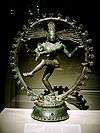Omkareshwar
| Omkareshwar Jyothirlinga | |
|---|---|
|
Omkareshwar Mahadev Temple | |
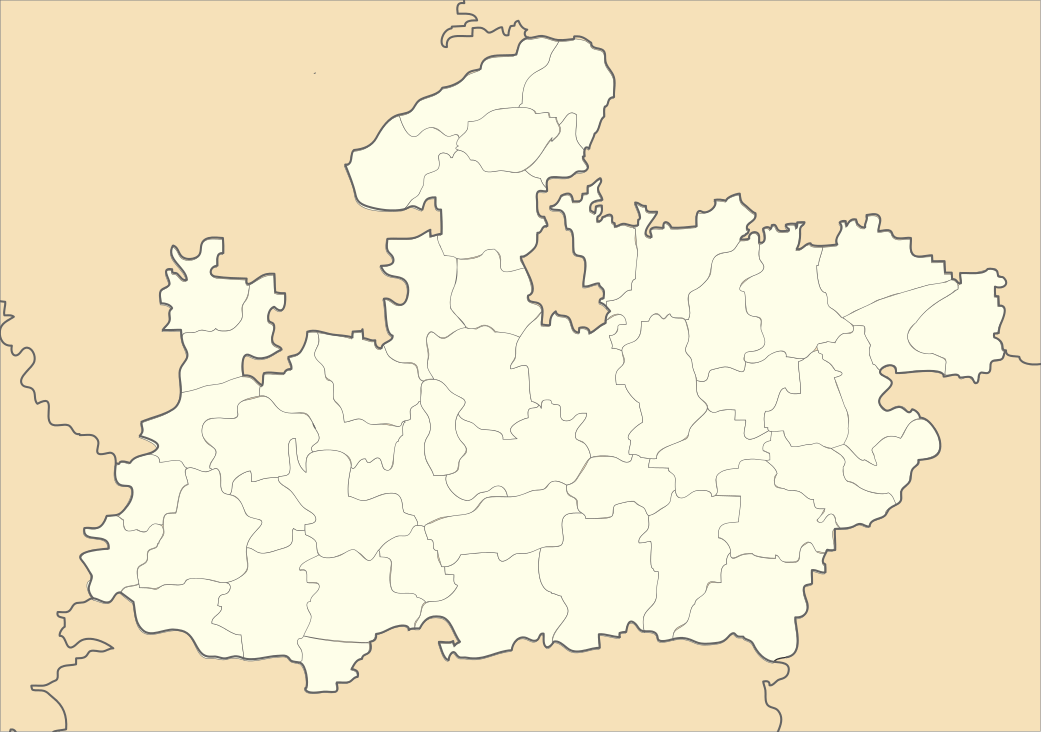 Omkareshwar Jyothirlinga Location in Madhya Pradesh | |
| Name | |
| Proper name | ओंकारेश्वर |
| Devanagari | ओमकारेश्वर जोतिर्लिंग |
| Sanskrit transliteration | Ōmkārēśhvar |
| Marathi | ओंकारेश्वर जोतिर्लिंग |
| Geography | |
| Coordinates | 22°14′44.1″N 76°09′03.8″E / 22.245583°N 76.151056°ECoordinates: 22°14′44.1″N 76°09′03.8″E / 22.245583°N 76.151056°E |
| Country |
|
| State | Madhya Pradesh |
| District | Khandwa |
| Location | Madhya Pradesh, India |
| Culture | |
| Primary deity | Omkareshwar(Shiva) |
| History and governance | |
| Website | http://www.shriomkareshwar.org |
Omkareshwar (Hindi: ओंकारेश्वर Ōṃkārēśvar) is a Hindu temple dedicated to God Shiva. It is one of the 12 revered Jyotirlinga shrines of Shiva.[1] It is on an island called Mandhata or Shivapuri in the Narmada river; the shape of the island is said to be like the Hindu ॐ symbol.
There are two main temples of Lord Shiva here, one to Omkareshwar (whose name means "Lord of Omkaara or the Lord of the Om Sound") located in the island and one to Amareshwar (whose name means "Immortal lord" or "lord of the Immortals or Devas") located on the south bank of Narmada River on the mainland.[2] As per the sloka on dwadash jyotirligam, Mamleshwar the other name of Amareshwar is the jyotirling, nonetheless, many consider both Omkareshwar and Mamleshwar equally sacred and representative of jyotirling at this sacred place.
Jyotirlinga
As per Shiv Mahapuran, once Brahma (the Hindu God of creation) and Vishnu (the Hindu God of Protection and Care) had an argument in terms of supremacy of creation.[3] To test them, Shiva pierced the three worlds as a huge endless pillar of light, the jyotirlinga. Vishnu and Brahma split their ways to downwards and upwards respectively to find the end of the light in either directions. Brahma lied that he found out the end, while Vishnu conceded his defeat. Shiva appeared as a second pillar of light and cursed Brahma that he would have no place in ceremonies while Vishnu would be worshipped till the end of eternity. The jyotirlinga is the supreme partless reality, out of which Shiva partly appears. The jyothirlinga shrines, thus are places where Shiva appeared as a fiery column of light.[4][5] Originally there were believed to be 64 jyothirlingas while 12 of them are considered to be very auspicious and holy.[3] Each of the twelve jyothirlinga sites take the name of the presiding deity - each considered different manifestation of Shiva.[6] At all these sites, the primary image is lingam representing the beginningless and endless Stambha pillar, symbolizing the infinite nature of Shiva.[6][7][8]
The twelve jyothirlingas are Somnath in Gujarat, Mallikarjuna at Srisailam in Andhra Pradesh, Mahakaleswar at Ujjain in Madhya Pradesh, Omkareshwar in Madhya Pradesh, Kedarnath in Himalayas, Bhimashankar in Maharashtra, Viswanath at Varanasi in Uttar Pradesh, Triambakeshwar near Nashik in Maharashtra, Vaidyanath at Deogarh in Jharkhand, Nageswar at Dwarka in Gujarat, Rameshwar at Rameswaram in Tamil Nadu and Grishneshwar near Aurangabad, Maharashtra in Maharashtra.[3][9]
Legends and history
Omkareshwar Jyotirlinga also has its own history and stories.Three of them are prominent. The first story is about Vindhya Parvat (Mountain). Once upon a time Narada (son of Lord Brahma), known for his non-stop cosmic travel, visited Vindhya parvat. In his spicy way Narad told Vindhya Parvat about the greatness of Mount Meru. This made Vindhya jealous of Meru and he decided to be bigger than Meru. Vindhya started worship of Lord Shiva to become greater than Meru. Vindhya Parvat practiced severe penance and worshipped parthivlinga (A linga made from physical material) along with Lord Omkareshwar for nearly six months. As a result, Lord Shiva was pleased and blessed him with his desired boon. On a request of all the gods and the sages Lord Shiva made two parts of the lingas. One half is called Omkareshwara and the other Mamaleshwar or Amareshwar. Lord Shiva gave the boon of growing, but took a promise that Vindhya will never be a problem to Shiva's devotees. Vindhya began to grow, but did not keep his promise. It even obstructed the sun and the moon. All deities approached sage Agastya for help. Agastya along with his wife came to Vindhya, and convinced him that he would not grow until the sage and his wife returned. They never returned and Vindhya is there as it was when they left. The sage and his wife stayed in Srisailam which is regarded as Dakshina Kashi and one of the Dwadash Jyotirlinga.
The second story relates to Mandhata and his son's penance. King Mandhata of Ikshvaku clan (an ancestor of Lord Ram) worshipped Lord Shiva here till the Lord manifested himself as a Jyotirlinga. Some scholars also narrate the story about Mandhata's sons-Ambarish and Muchukunda, who had practiced severe penance and austerities here and pleased Lord Shiva. Because of this the mountain is named Mandhata.
The third story from Hindu scriptures says that once upon a time there was a great war between Devas and Danavas(demon), in which Danavas won. This was a major setback for Devas and hence Devas prayed to Lord Shiva. Pleased with their prayer, Lord Shiva emerged in the form of Omkareshwar Jyotirlinga and defeated Danavas.
Adi Shankara's Cave - Omkareshwar is said to be the place where Sri Adi Sankara met his Guru Govindapada in a cave. This cave can be found even today just below the Shiva temple where an image of Adi Shankara has been installed.[10]
Location
It is situated in the Khandwa district of Madhya Pradesh state in India. It is about 12 miles (20 km) from Mortakka in Madhya Pradesh.
Omkareshwar is formed by the sacred river Narmada. This is one of the most sacred of rivers in India and is now home to one of the world's biggest dam projects.
Places of interest
On the Island[11]
- Omkareshwar Palace, located to little North West of Omkareshwar Temple is a moderately sized building which is well maintained
- Omkareshwar Temple - the temple is a five storied structure, each level dedicated to a different God. Mahakaleshwar, Sidhnath, Gupteshwar and Dhwajeshwar temples are located on the upper floors.
- Govindeshwar temples and Adi Shankara cave - The temple is located near the entrance to the Omkareshwar temple. This cave located below the Shiva temple where an image of Adi Shankara has been installed. Sri Adi Shankara is said to have met his Guru Govindapada in a cave.
- Ram Ghat, south of Omkareshwar Temple
- Gurudwara, Omkareshwar Sahib, westerly to Ram ghat - this is believed to be the place where Guru Nanak stayed while at Omakareshwar
- Siddhanath Temple - an exquisitely carved masterpiece temple is located little easterly to Omkareshwar
- Gayathri Shaktipeet, close to bridge
- Omkar mutt, located westerly to Omkareshwar
- Shri Nikhildham Siddhashram, opp to Omakr Mutt
- Shri Anandamayi Maa Ashram
- Ramakrishna Mission, Sadhana Kutir
- Rin Mukteshwar Mahadev Mandir - a small temple where devotees offer pulses to get a relief from all past Rin
- Sangam Ghat - a picturesque place located in the western most point of the island which is the sangam point. Lord Kuber, cousin of Ravana was elevated from being an ordinary Yakshi, a demigod to becoming king of all Yakshas, and Lord of wealth.
From sangam further travel along the north bank of the island takes to several temples, most located on a hillock. Many of the old structures are repaired, and many modern temples have come up here.
- Gori or Gauri Somnath Temple; Mama Bhanja Mandir - temple here houses a huge 6 ft tall shivaling and an impressive green coloured Nandi in front. Two adults embracing lingam cannot reach their hands unless they are an uncle and nephew (Mama-Bhanja). As per a belief, if anyone looked through the idol one would see the figure of his next birth. Aurangazeb saw an image of a pig in the idol, and in a rage he tried damaging it. This place also houses a museum nearby.
- Lete Hanuman Mandir or Patali Hanuman Mandir - house a large idol of reclining Hanuman. Of note, this place is replete with many monkeys to which all devotees are extremely tolerant.
- Maa Raj Rajeshwari Mandir and Ram mandir - Rajrajeshwari Seva Sanstshan Trust has also constructed here a Ved pathshala, Annadhana khetram, Old age home and Hospital.There is a 90 ft tall Shiva statue here.
- Kailsh Dham trust - further easterly, the trust has bulit a temple, Nakshtra garden representing nine palnets, and Fift Store. This place is serene where pilgrims on a parikrama rest.
On the south bank of Narmada River[12]
- Mamleshwar or Amareshwar temple - this is considered to be the oldest temple here. This is a small temple, yet very sacred, and pilgrimage to Omkareshwar is considered incomplete if this temple is not visited.
- Sree Gajanan Maharaj complex - is located south-east of Mamleshwar. The temple is built of marble and intricately designed. Devotees do not miss this temple.
- Vrihdeshwar Temple is located close to Mamleshwar temple.[13] Ask locally to locate this temple.
- Gau or Gomukh ghat on Narmada is located close the bridge. Boat rides are available from this point. Pilgrims can take boats either to cross the river or to cruise around the island. Also, night ride is popular to Witness Aarti at the bank.
- Vishnu Mandir is loaced close to Gau ghat. It is a small yet beautifully built temple
- Westerly to the Gau ghat and bridge are located, Nagar Ghat; Markandey Sanyas Ashram; Annapurna temple complex and Abhay Ghat. This ares is very well maintained. The Annapurna Temple Trust of Indore has raised a complex around an ancient Annapurna temple in Markandeya ashram premises. A Sarva Mangala temple has been developed inside the complex dedicated to the three Goddesses Laxmi, Parvati, and Saraswati. A 35 feet tall statue of Lord Krishna is the main attraction here.
Transport
There are steamboats across the Narmada river and also two connecting bridges to reach the temple.
Air : The Airport close to Omkareshwar is at Indore (77 km).
Rail : Nearest Railway Station is at Omkareshwar Road railway station (12 km) on the Ratlam-Khandwa section of the Western Railway which is not a mainline. The other nearest railway station connected to Delhi and Mumbai is at Indore (77 km).
Road : Omkareshwar is connected to major towns and cities of Madhya Pradesh. There are regular bus services from Ujjain (133 km), Indore (77 km), Khandwa (61 km.) and Omkareshwar Road (12 km). By bus, it takes 2.5 hrs from Khandwa railway station to Omkareshwar.
Gallery
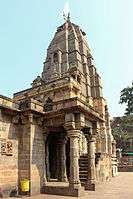 Mamleshwar Temple
Mamleshwar Temple Sculpture at Mamleshwar Temple
Sculpture at Mamleshwar Temple Sculpture at Omkareshwar Temple
Sculpture at Omkareshwar Temple- Mamleshwar Jyotirlinga
 One of the temple shrines
One of the temple shrines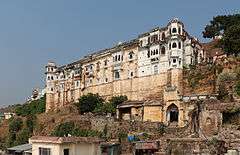 Omkareshwar Palace
Omkareshwar Palace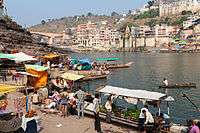 Gomukh ghat
Gomukh ghat View of Narmada
View of Narmada Omkareshwar temple view
Omkareshwar temple view
References
- ↑ http://omkareshwar.org/omkareshwar-jyotirlinga
- ↑ "Omkareshwar Temple".
- 1 2 3 R. 2003, pp. 92-95
- ↑ Eck 1999, p. 107
- ↑ See: Gwynne 2008, Section on Char Dham
- 1 2 Lochtefeld 2002, pp. 324-325
- ↑ Harding 1998, pp. 158-158
- ↑ Vivekananda Vol. 4
- ↑ Chaturvedi 2006, pp. 58-72
- ↑ http://www.columbuslost.com/2015/03/omkareshwar-narmada-yatra.html
- ↑ http://www.shriomkareshwar.org
- ↑ http://omkareshwar.org
- ↑ http://www.shriomkareshwar.org/HOtherTemples.aspx
External links
| Wikimedia Commons has media related to Omkareshwar Temple. |
- Official Website
- http://omkareshwar.org
- http://www.madhya-pradesh-tourism.com/tourist-attractions/omkareshwar.html
- http://www.khandwa.nic.in/tourism.htm
- https://www.myoksha.com/omkareshwar-temple
- http://www.templenet.com/Madhya/Omkareshwar.htm
- Google Earth view
Notes
- Chaturvedi, Jyoti. (2006), Shiv Purana (First ed.), New Delhi: Diamond Pocket Books (P) Ltd, ISBN 81-7182-721-7
- Eck, Diana L. (1999), Banaras, city of light (First ed.), New York: Columbia University Press, ISBN 0-231-11447-8
- Gwynne, Paul (2009), World Religions in Practice: A Comparative Introduction, Oxford: Blackwell Publication, ISBN 978-1-4051-6702-4.
- Harding, Elizabeth U. (1998). "God, the Father". Kali: The Black Goddess of Dakshineswar. Motilal Banarsidass. pp. 156–157. ISBN 978-81-208-1450-9.
- Lochtefeld, James G. (2002), The Illustrated Encyclopedia of Hinduism: A-M, Rosen Publishing Group, p. 122, ISBN 0-8239-3179-X
- R., Venugopalam (2003), Meditation: Any Time Any Where (First ed.), Delhi: B. Jain Publishers (P) Ltd., ISBN 81-8056-373-1
- Vivekananda, Swami. "The Paris Congress of the History of Religions". The Complete Works of Swami Vivekananda. Vol.4.

